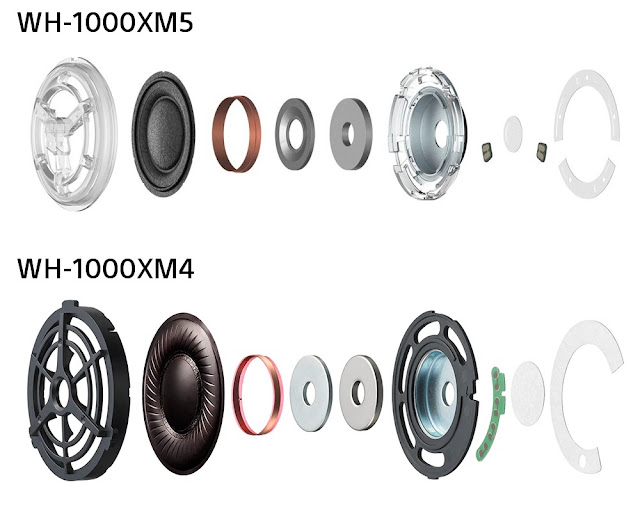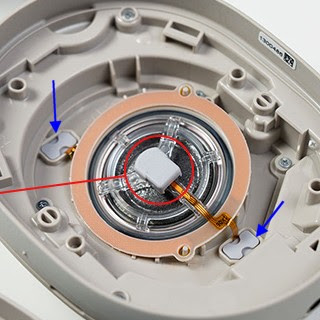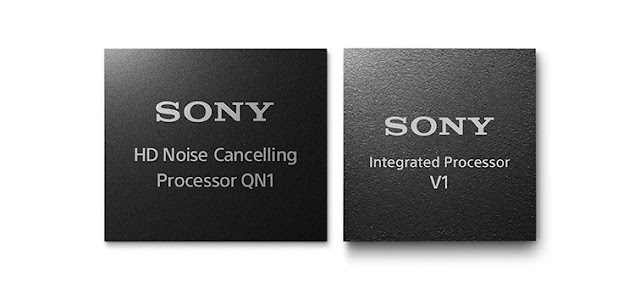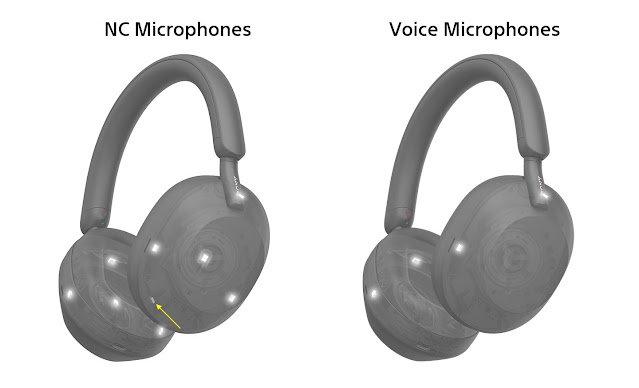The Sony WH-1000XM5 are finally here. If people wish to read some early reviews, there quite a few out there from Gizmodo, Wired, the Verge, etc. If I end up buying a pair, I may post up a review but I do not have the WH-1000XM4, so I could not compare the two. I will go over some of the new things that were finally revealed today that caught my attention.
Price and Availability
From the press release for Europe, the headphones are expected to ship at the end of May for around 420 Euros (379 GBP, $399 USD, $499 CAD). The US release date is May 20th at Best Buy and Amazon. I am not sure if other regions will get these at the same time or the release will be staggered. Like previous models, for the time being we will only have the Black and Platinum Silver colour options. Hopefully a white model shows up later this year.
Features
Multipoint is present like in the previous model along with DSEE Extreme, with Fast Pair now being supported. For users on Windows 10/11, the model adds Swift pair which should help connecting the
headphones to laptops and PC tablets. Likewise support for Dolby Atmos
experience, and 360 Reality Audio, remain. The Speak-to-chat function carries over as well.
Codec support is the same as previous, AAC/SBC and LDAC. Hopefully once LE Audio is released, Sony will update the WH-1000XM5 to support the new LC3 codec. I suspect the model would need to go through Bluetooth certification again for LE Audio support. Interestingly, the WH-1000XM5 still has not appeared on Bluetooth SIG itself. And update, today the WH-1000XM5 has appeared on Bluetooth SIG finally, together with the WH-XB910N.
There is also support for Google, Siri and Alexa. The WH-1000XM5 also now support Spotify tap, which uses taps, 2 or 3 to control music playback in Spotify. This function is configured in the Sony Headphone App.
Battery Life
Battery life is still rated at 30 hours with NC on and now up to 40 hours with
NC off. Unfortunately there is no mention what codec is used and which
other settings are enabled/disabled. but my money is on AAC/SBC, with Speak-to-Chat and DSEE Extreme both set to off.
A full recharge now requires 30 more minutes for a total of 3.5 hours. Using an optional USB-PD compatible AC adapter, a quick 3 minute recharge provides up to 3 hours of use. This optional AC adapter is not included with the headphones sadly. I suspect the headphones make use of the 9V power delivery USB option, since we saw both 5V and 9V on the FCC documents for power rating. The WH-1000XM4 offered a 10 minute quick recharge which provided up to 5 hours of playback. but this did require a 1.5A AC adapter, again optional. Granted the new model is able to charge faster, 1 min recharge providing 1 hour, where as before 1 min recharge only provide 30 minutes of use.
Most newer laptops do provide a power delivery USB port, but most regular ports are still 5V I believe, so no idea if the 3.5 hours of recharging is for 5V or the 9V, I suspect 5V.
Will be interesting to see if the battery capacity has remained the same or been reduced.
New Driver
I am sure Sony Japan will have an interview with the WH-1000XM5 engineers with regards to this new driver, so I will either update the post here or make a new one with the interview if the content is big enough.
Sony interview
The interview with the engineers does provide some new information. The diaphragm for example is now made out of 2 different materials, so that the inner dome is lightweight yet rigid and the outer portion more softer. This results in a higher amplitude of movement which increases the bass range. Interesting enough, it took Sony 5 years to develop this type of diaphragm. Perhaps this new diaphragm design is why the driver is smaller, either Sony could not get it to work at 40mm just yet, or the 30mm driver is just as good or even better than the standard 40mm driver.
Likewise Sony used gold in the solder for the contacts for the driver, which apparently improves the sound quality. This was a trick learned from the Walkman team designing the NW-WM1M2. But Sony says this does not magically improve the sound quality by itself. Sony also optimized the layout of the PCB and used a larger higher quality sound resistor which is also used in the Walkman. Will be cool to see if we can spot this in the teardown.
Interesting enough one small photo does provide a glimpse at the driver and feedback microphone. The photo below shows rather than wires, Sony has opted for ribbon cables connecting both the feedback microphone and the driver to the PCB. This is very different than previous WH headphones and more in line with the WF line.
Noise Cancellation
Microphones
Recall back to my earlier post, where I was analyzing the amount of microphones. From the leaked photos, I summarized we would have at least 8 microphones in total, 4 NC mics, and 4 mics for voice, But looking at the new photos, I believe we might have 9 in total.
The one microphone not highlighted by Sony is beside the arrow, which looks to correspond to the microphone in the photo below.
With 9 microphone inputs, Sony has to utilize both the Bluetooth SoC (V1) and the QN1 chip to handle all the connections. The MT2822 (V1) has a maximum of 5 microphone inputs, so this leaves 4 which require another chip. Like I wrote above, I suspect the QN1 is doing the bulk of the NC work, but there are no datasheeets for the QN1, so we have no idea how many mics it can support in total.
One thing apparent from Sony's photo is that all of the microphones are now MEMS type with no more electret mics anywhere on the headphones. This in itself should improve the sound quality for the voice and noise cancellation.
Sony Interview
The interview does provide some answers why there are 2 chips. Because there are twice as many microphones (according to Sony), the processing power needed to be increased greatly. The QN1 does seem to perform the major NC function with the V1 assisting. This distribution of processing power enables the WH-1000XM5 to process more complicated noise signals.
Therefore with all the extra microphones, Sony is able to decrease the noise like traffic and now can also decrease people's conversations. The WH-1000XM5 is also equipped with an auto NC optimizer, which automatically optimizes the noise cancellation.
Check out the video below from The Verge, where they compare the voice mics on the WH-1000XM5, WH-1000XM4, Apple Airpods Max and the Bose 700.
Listening to the comparison, the WH-1000XM5 sounds on par if not better than the Bose 700. The WH-1000XM4 sound a bit muddled or as if the audio is heavily compressed. The Airpods Max sound good but I can hear a lot more compression in some instances versus the Bose and Sony WH-1000XM5. Ideally, the reviewer should say the same sentence on all headphones for a more direct comparison. What do you guys think? Which sounds best in the video? Leave your comments below.
For those wondering how large the new carrying case is, Gizmodo has 2 comparison photos in their review. The CNET review also has one comparison photo, with their review complaining about the larger size. The Verge also complains the case is significantly larger than the old one. The complaints are understandable and will have some users opting for other brands since the WH-1000XM5 case is just a bit too big. Without the headphones, the case can collapse and be around 40% thinner than the previous case according to Sony.
Inside the case is a small storage pocket for the headphone and USB cables, but no more plane adapter. I wonder a USB-PD AC adapter would fit into this small storage pocket as well.
Brand new design with improved wearing comfort
The new redesign brings newly developed soft fit leather to the earpads, which Sony says "fits snugly around the head with less pressure on the ears while keeping out external sounds". In addition the slider is now stepless, making the joints now silent. These changes will hopefully address some of the issues users were complaining about with the creaking and squeaking in the hinge area. This full redesign ultimately ends up making the WH-1000XM5 more comfortable to wear for extended periods of time. This fact is rather important since a larger heavier model will become uncomfortable, regardless how good they look.
The weight has also been reduced by 4 grams to 250g. This was achieved by shaving off small 0.1g increments from as many parts as possible. Hopefully this means the battery capacity remains the same as before.
I am still trying to figure out if the headband/hinge has some metal in it but I suspect it is not.
For those curious, the Sony Engineer interview can be found here. It is in Japanese, so Google translate will be required.












@Ascariss: Not related to this post, but I noticed in the Xperia 1 IV announcement video, as well as in the official product video, that they mention it's ready for Bluetooth LE Audio and in the same slide, right next to the Xperia 1 IV, there is also a WF-1000XM4.
ReplyDeleteIt could mean nothing, but it's interesting regardless, here is a screenshot:
https://imgur.com/a/E71SXXM
Also, the links to the mentioned videos. here in the announcement video at 16:56:
https://www.youtube.com/watch?v=RLaDk1xzho4
And here in the official product video at 5:57:
https://www.youtube.com/watch?v=eZOJbWMx9yI
I suspect we will see LE audio either end of the year or maybe early next year at the earliest. I suspect the WH-1000XM5 will get an update for support, but perhaps the WF-1000XM3 will not and only the WF-1000XM5 will get LE audio support.
DeleteWhy the heck, shouldn't they want LESS microphones but of higher quality for ANC? SNR is significantly reduced everytime you add a mic into the equation supposedly, and the lower the SNR the more the self noise and lower the ability to cancel quieter noises.
ReplyDeleteThe interview seems to say it just improves the person's voice and everyday noise compared to XM4 so i hope they didn't hide any tradeoffs on low freq cancelling and hid them by claming "it's the same we swear".
sadly they'll never add a one mic-only ANC mode...
nice
ReplyDelete